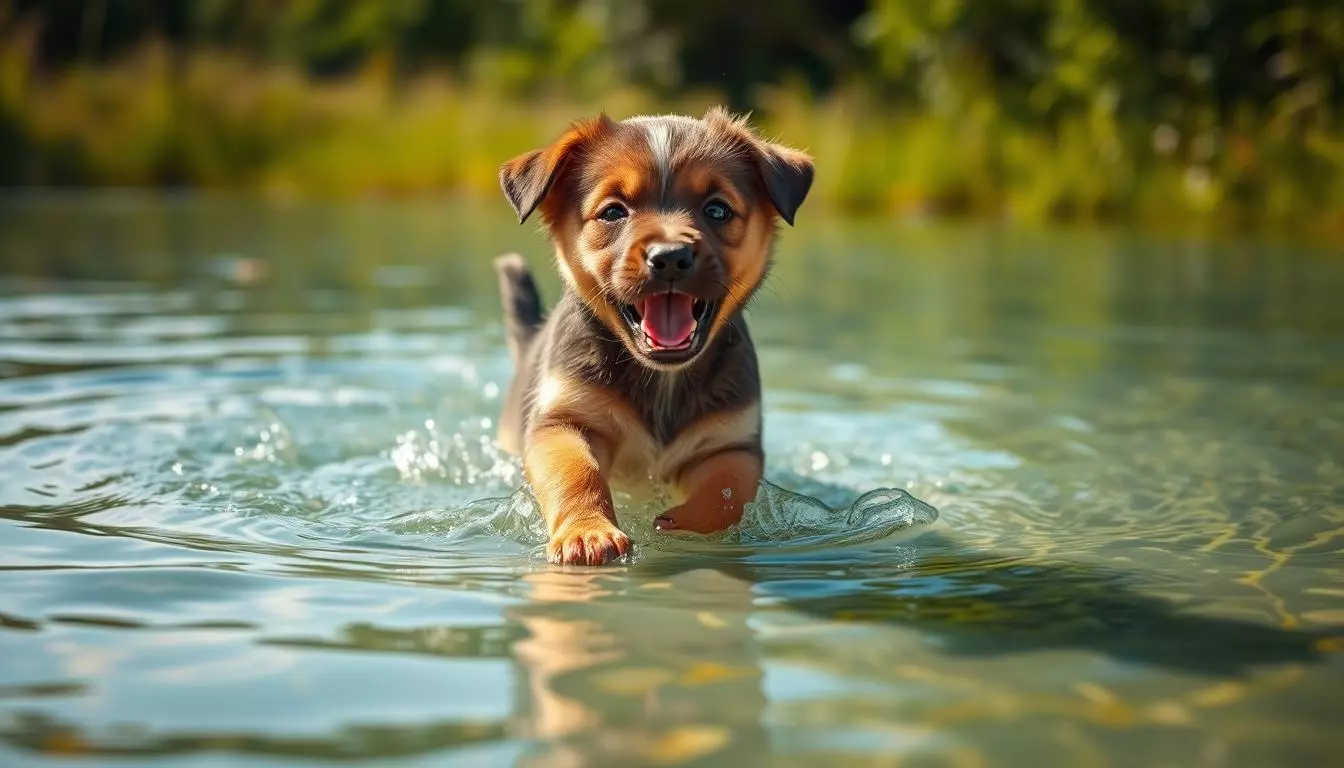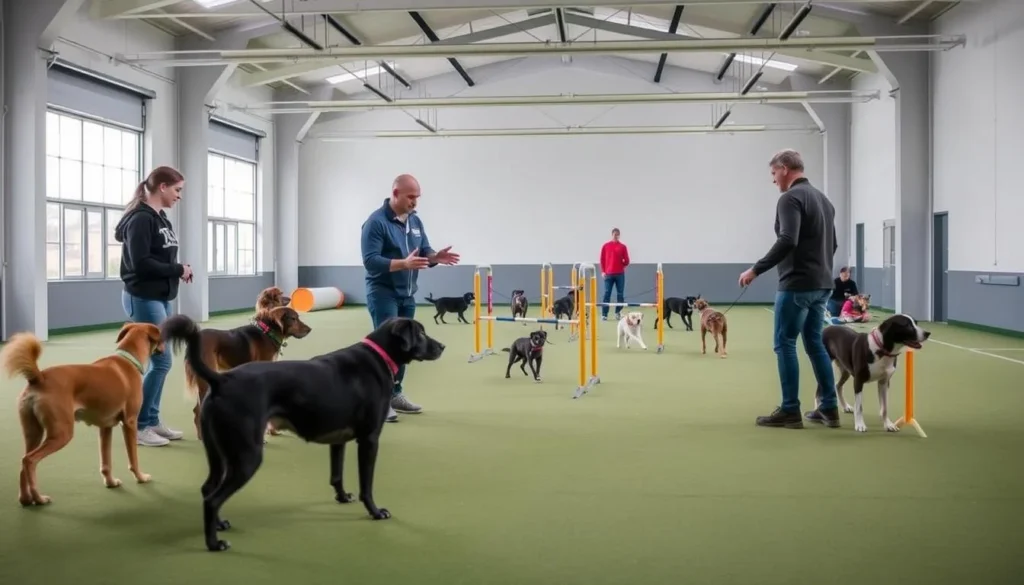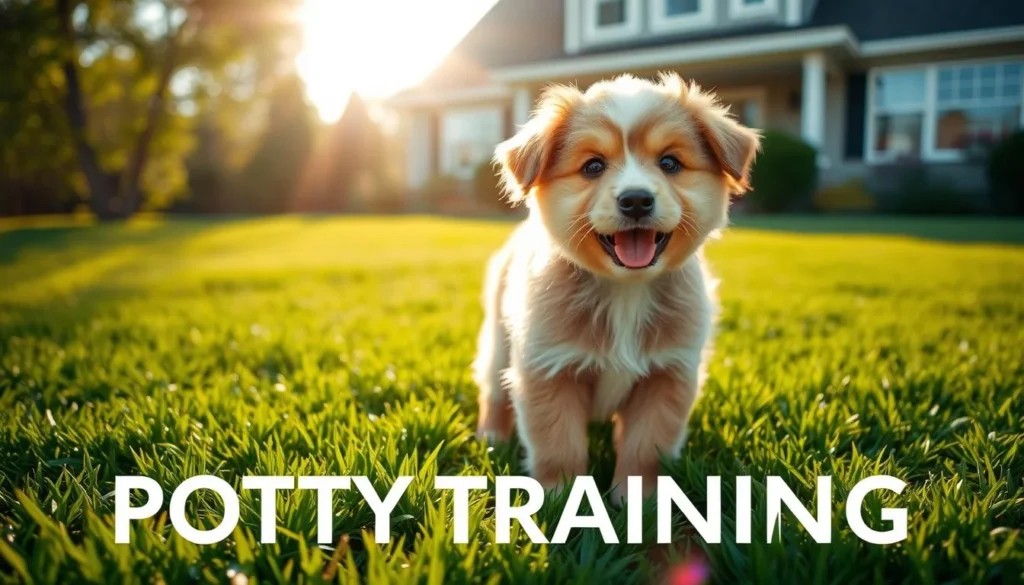Watching a puppy discover water is truly magical. It brings back memories of when I first taught my pup to swim. We both felt a mix of excitement and nervousness.
The splashes and wagging tails are unforgettable. They show that teaching a dog to swim is more than safety. It's an adventure that strengthens our bond.
In this guide, I'll share tips on how to teach a puppy to swim. We'll make sure they learn the basics and have fun. So, let's explore why puppy swimming lessons are great for your dog's development!
Key Takeaways
- Puppy swimming lessons can enhance your dog's overall well-being.
- Swimming promotes natural instincts and builds confidence in puppies.
- Proper guidance is essential for a positive swimming experience.
- Assessing your puppy’s comfort level is crucial before starting lessons.
- Safety equipment, like life jackets, should always be a priority.
- Introduce your puppy to water gradually for the best results.
Understanding Your Puppy’s Natural Swimming Instincts
Every puppy has its own swimming instincts shaped by its breed, personality, and water experiences. My dog loves to paddle in the pool, but not all dogs are the same. Some, like Labradors, are naturally good swimmers, while others might be hesitant.
It's important to watch how your puppy reacts to water. Some jump right in, while others need a gentle start. Knowing your puppy's unique traits helps build their confidence and makes swimming a positive experience. Tailoring the experience to each puppy's natural instincts is key to their comfort and skill in the water.
Why Swimming is Beneficial for Dogs
Swimming is great for dogs and their owners should think about it. It helps dogs physically and mentally. It's a fun way for dogs to exercise without hurting their joints.
Physical Health Benefits
Swimming is amazing for a dog's health. It makes their muscles strong and their heart healthy. It's perfect for puppies growing fast or dogs recovering from injuries.
It's also good for dogs with arthritis because it's easy on their joints. Swimming helps dogs stay fit and healthy, keeping them full of energy.
| Physical Health Benefits | Benefits Description |
|---|---|
| Improved Muscle Strength | Swimming ensures all muscle groups are engaged, leading to enhanced strength. |
| Improved Cardiovascular Health | Regular swimming routines positively impact heart health. |
| Joint Relief | Water provides buoyancy, alleviating stress on joints during exercise. |
| Weight Management | Low-impact activity aids in weight control and promotes fitness. |
Mental Health and Confidence Boosts
Swimming is not just good for a dog's body; it's also great for their mind. It keeps them active and calm. Many dogs love swimming and feel more confident in the water.
This confidence can help them in other areas of life. It makes them more balanced and secure.
Assessing Your Puppy’s Suitability for Swimming
When thinking about letting my puppy swim, I first check if they're suited for it. Not every dog is good in the water. Knowing which breeds are better at swimming is key to a fun and safe time for my pet.
Breed Considerations
Some dogs are naturally better at swimming than others. For example, labs and retrievers are great in the water. But dogs like Bulldogs and Dachshunds might struggle because of their body shape. I do my research on my puppy's breed to make sure they have a good time swimming.
Age and Health Factors
Age and health are also important when it comes to swimming. Experts say to start swim training when your puppy is about four months old. This is after they've had all their shots. For older dogs or those with health problems, I'm extra careful before letting them swim. Knowing my puppy's health and fitness helps me keep them safe while swimming.
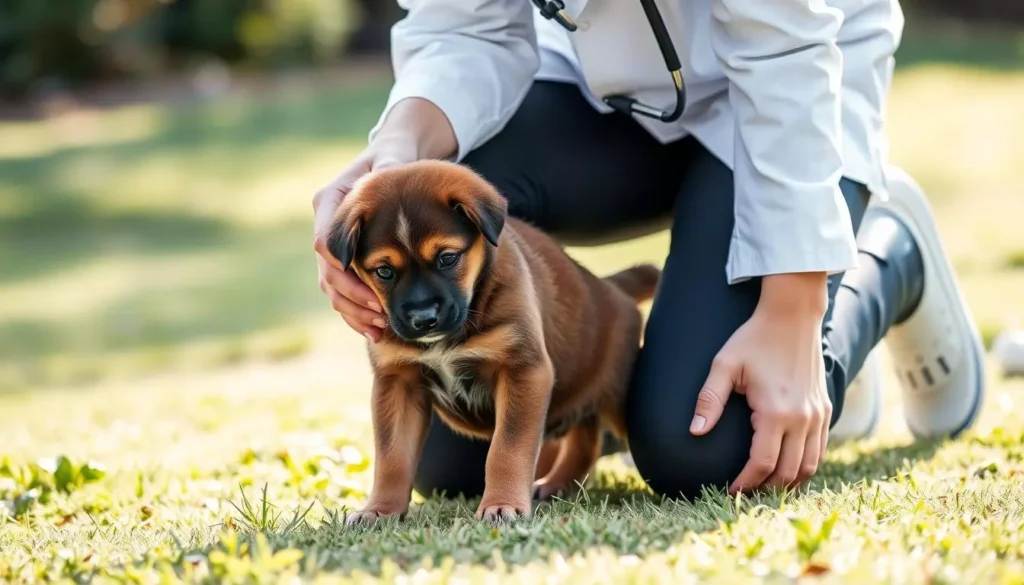
Preparing Your Puppy for Swimming Lessons
Getting ready for puppy swimming lessons starts with finding the perfect spot. The right location for dog swimming is key for a good start. A calm, shallow area makes puppies feel safe and happy.
Places like kiddie pools or quiet lakes are great. They offer a safe space for puppies to explore without feeling scared.
Choosing the Right Location
When picking a spot for swimming lessons, think about these things:
- Shallowness: Make sure the water is shallow so your puppy can stand easily.
- Calm Waters: Stay away from busy spots with strong currents or waves that might scare your puppy.
- Safe Environment: Choose a clean, familiar place where your puppy can relax and have fun.
Essential Gear: Life Jackets and Toys
To keep my puppy safe and happy, I get the right gear for swimming. A good life jacket boosts confidence and safety in the water. It should fit well and be made for dogs.
Adding floating toys makes swimming fun and keeps my puppy interested. It makes the lessons enjoyable for both of us.
| Essential Gear | Purpose | Notes |
|---|---|---|
| Life Jacket | Provides safety and buoyancy | Ensure it fits securely but comfortably |
| Floating Toys | Encourages play and engagement | Choose toys that are durable and safe for water use |
| Water Bowl | Keeps your puppy hydrated | Available at all times, especially during lessons |
Preparing for puppy swimming lessons means planning carefully. It's about choosing the right spot and getting the right gear. These steps help us both have a great time in the water.
Starting Slow: Introducing Your Puppy to Water
Introducing a puppy to water should be done slowly and carefully. I start with shallow, calm water to make them feel safe. This helps them get used to the water without feeling scared.
Using non-slip surfaces helps puppies who are hesitant. It makes them feel more confident. I make the experience fun by using treats and praise. This way, they start to enjoy the water.
How to Teach a Puppy to Swim
Teaching a puppy to swim is rewarding for both of us. It's a fun and safe process. I start slowly and use positive reinforcement at every step.
Step-by-Step Guide
I begin by taking my puppy to shallow water. This makes them feel safe. I also use a life jacket for extra safety. Here's how to do it:
- Start in shallow water—allow your puppy to walk and explore.
- Encourage natural paddling by gently supporting them.
- Use positive reinforcement, offering treats when they show interest in the water.
- Gradually introduce deeper sections as they gain confidence.
Creating Positive Associations with Water
It's important to make water a positive place for my puppy. I make each visit fun with play and games.
- Play with toys that float to spark curiosity.
- Use treats wisely—reward my puppy each time they interact with water.
- Remain calm and use a friendly tone to create a reassuring environment.
This way, my puppy learns to love swimming. They also learn to enjoy being in the water.
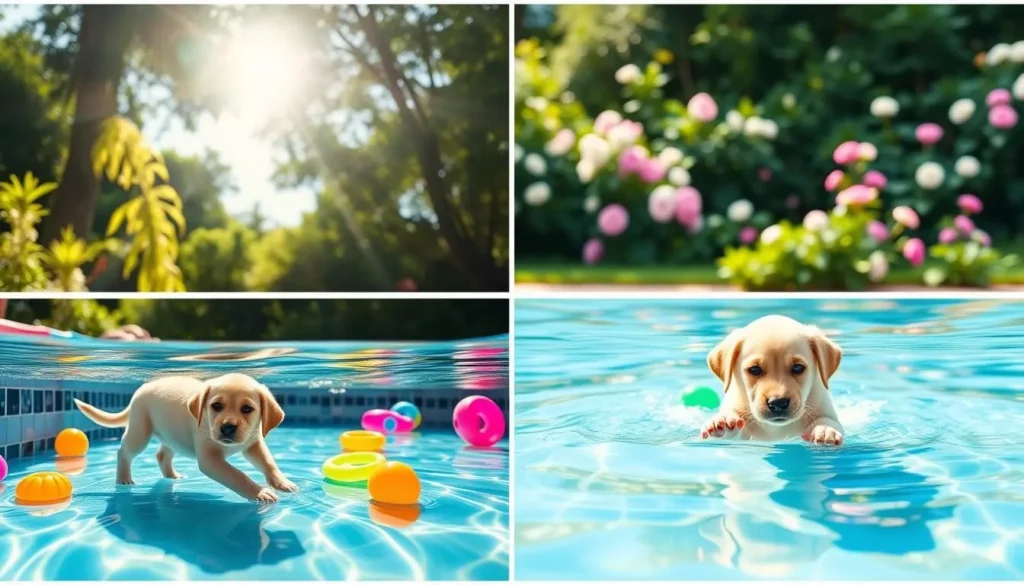
Puppy Pool Introduction: What to Expect
Introducing your puppy to water can be exciting, especially with kiddie pools. These pools are small and shallow, making them perfect for puppies to learn about water. It's a fun and safe way to help them get used to water.
Watching your puppy's reactions is key. Look for signs that they're enjoying themselves. This helps you know if they're comfortable and ready to learn.
Using Kiddie Pools for Initial Lessons
Kiddie pools are great for teaching puppies to swim. They're shallow, so puppies can explore without feeling scared. Watching my puppy, I see them play and splash in the water.
When they start to play with their paws in the water, it's clear they're having fun. It's a great sign they're comfortable and ready to learn.
Signs of Comfort and Hesitation
It's important to know when your puppy is comfortable in the water. If they wag their tail and bark excitedly, they're feeling good. But, if they move slowly or whine, they might be hesitant.
Understanding these signs helps you adjust your approach. If your puppy seems uncomfortable, give them space. Let them learn at their own pace.
Building Confidence in Water
Building confidence in water is key for a good swimming experience. I start with shallow water and gradually increase the depth. This helps my puppy feel more comfortable and confident in the water.
Gradual Depth Increases
I let my puppy set the pace when we increase the water depth. We begin with a few inches of water. As they get more comfortable, we can go deeper, but always at their pace.
This approach helps them feel secure and curious about swimming.
Using Treats for Motivation
Treats are a great way to motivate my puppy. Positive reinforcement helps build their confidence. When they swim further or show good behavior, I give them a treat.
This makes swimming fun and rewarding for them. Seeing their progress is very satisfying.
Water Safety Tips for Your Puppy
When I introduce my puppy to water, safety is my top priority. Always watching them while they swim is a must. Even if they're good swimmers, surprises can happen, so it's crucial to keep a close eye.
Using a life jacket is another important step. It makes my puppy feel safe in the water, especially if they're still learning. I choose a bright color so I can easily see them.
Teaching basic commands is key for swimming safety. Commands like “come” or “stay” help me communicate with my puppy in the water. This training keeps them safe and makes swimming fun.
I also check the water conditions carefully. I look out for strong currents, rough waves, or wildlife. Keeping my puppy in a safe area makes their swimming fun and safe.
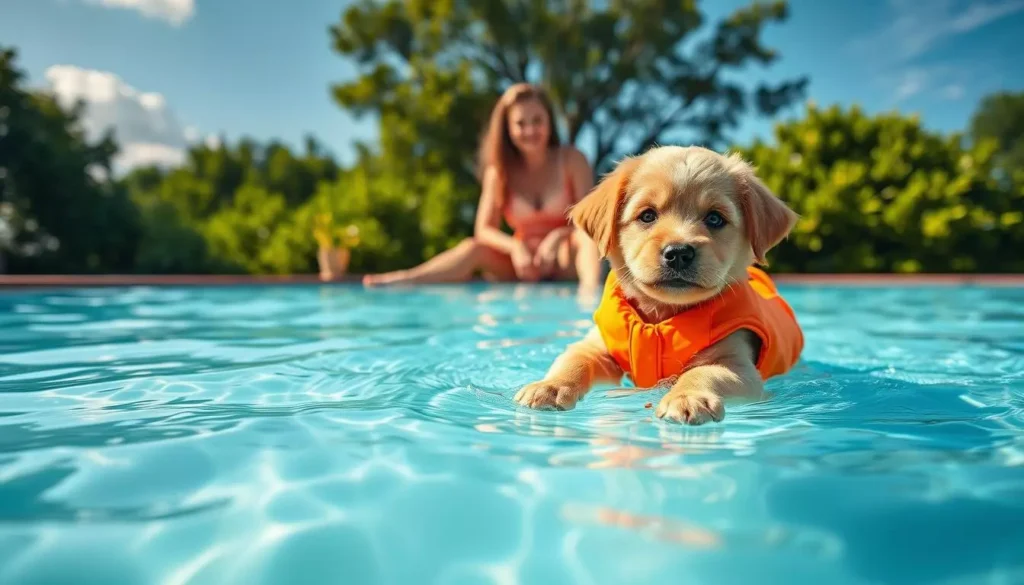
Common Mistakes to Avoid During Swimming Lessons
Learning to swim can be tough for puppies. It's important to avoid common mistakes in puppy swimming lessons. One big mistake is forcing a puppy into the water. This can make them scared and anxious.
Instead, I suggest a gentle introduction. Let the puppy explore the water at their own pace. This way, they can get used to it without feeling forced.
Forced Entry vs. Gentle Introduction
Forcing a puppy into the water can cause lasting fear. It might make them never want to swim again. So, it's better to be patient and let them approach the water slowly.
Use positive reinforcement like treats and praise. Celebrate their bravery, no matter how small the steps. This makes the experience more enjoyable for them.
Overlooking Safety Equipment
Many pet owners forget to use safety equipment for dog swimming. Life jackets are crucial for puppies who might not float well. Good safety gear makes your puppy feel safe while they learn.
It also helps build trust and makes swimming more fun. So, always prioritize your puppy's safety in the water.
Training Sessions: How Long and How Often
How long you train your puppy is key to their learning and fun in swimming. Short sessions, about 5 to 10 minutes, keep them interested and full of energy. Puppies get tired fast, especially with new things like swimming.
Watching your puppy's energy while swimming makes it better for them. They need breaks to avoid getting too tired. By paying attention to how they act and look, you know when to stop and let them rest. This way, they stay excited to swim again.
Recognizing Signs of Distress in Your Puppy
Ensuring my puppy feels safe and comfortable while swimming is my top priority. It's important to notice when they might be uncomfortable. I look for small signs that show my pup is not okay.
Panting, Whining, and Other Signals
My puppy might show distress in different ways. Heavy panting is a clear sign that something is off. If they start whining, it means they're feeling scared or overwhelmed.
Excessive splashing or trying to get out of the pool are also signs. It's crucial to act fast when I see these signals. A quick reassurance and a break can make swimming a positive experience for them.
Encouraging Positive Experiences with Water
Making swimming fun for your puppy is key to loving water. Ending sessions on a high note boosts their confidence. This makes them want to swim more. Fun activities are crucial for a positive water experience.
Ending on a High Note
Ending each swim session with fun is important. It could be extra playtime or a game. This keeps them excited for water. Celebrating small wins, like swimming a bit, makes water a happy place.
Incorporating Games and Playtime
Adding games to swimming lessons makes it exciting. Games like fetch or splash games are great. They make swimming a fun adventure for your puppy.
- Fetch: Using a buoyant ball or toy that can float makes retrieval more fun.
- Splash Games: Encourage your puppy to splash through shallow water, rewarding them with praise and treats.
- Obstacle Courses: Set up floating obstacles for your puppy to navigate, fostering both agility and confidence.
These games make swimming memorable and build a lifelong love for it. With games, swimming becomes a fun part of our routine.
Outdoor Swimming Adventures: Planning Ahead
Planning outdoor swimming adventures with dogs needs careful thought. First, I check local rules about dog-friendly swimming spots. Some parks have special areas for dogs, while others don't allow pets. Knowing these rules helps avoid problems before we go.
Then, I make sure the area is safe for my puppy. I look for dangers like sharp objects, steep banks, or wild animals. I choose places with soft sand and clear water. It's also key to bring essentials like fresh water, a first-aid kit, and a life jacket for my puppy in deep water.
Lastly, I watch how my puppy acts around other dogs and people. This helps avoid any surprises during our swim. By following these steps, our outdoor adventures are fun and safe for both of us.
Post-Swim Care for Your Puppy
After a fun day in the water, it's key to take care of your puppy. Proper care ensures their health and happiness. This includes rinsing off chlorine or saltwater and keeping their skin healthy for more water fun.
Rinsing Off Chlorine or Saltwater
It's important to rinse off chlorine for puppies who swam in pools or saltwater. This prevents skin irritations and discomfort from chemicals. Use lukewarm water and a gentle pet shampoo to clean them.
Be sure to clean sensitive areas like ears, belly, and paws. A thorough rinse can greatly improve your puppy's comfort.
Skin Care and Hydration
After rinsing, skin care is crucial for swimming dogs. Dry your puppy with a soft towel to remove excess water and prevent skin issues. It's also important to keep them hydrated with fresh water.
Regularly check for any signs of skin irritation or injuries after swimming. This ensures your puppy stays happy and healthy for more swimming adventures.
Enhancing the Swimming Experience through Socialization
Socializing dogs during swimming is key to a positive experience for my puppy. When I introduce my puppy to other dogs in the water, it boosts their confidence. It also makes swimming fun. Seeing other dogs can calm my puppy, making them eager to explore the water.
Introducing Your Puppy to Other Swimming Dogs
To start socializing my puppy right, I focus on safe introductions to other swimming dogs. These meetings should be watched closely to keep everyone safe and happy. Here are some tips for good interactions:
- Choose calm, friendly dogs for the first introductions.
- Let my puppy watch other dogs swim from a distance before joining in.
- Play together with toys or games to encourage positive play.
- Keep a close eye on the interactions, stepping in if my puppy looks stressed.
Playing with other dogs makes swimming better for my puppy and strengthens our bond. Positive interactions help my puppy feel more confident in pools and lakes. This socialization is crucial, making future swims more fun and less scary.
Conclusion
Teaching puppies to swim is fun and important for their well-being. It boosts their confidence and keeps them healthy. It's also a great way to bond with your dog.
Every puppy learns at their own speed. So, patience and understanding are key. This helps them feel comfortable and excited to learn.
Positive reinforcement and gradual water introduction are crucial. This approach makes swimming a fun and safe experience for your puppy. It's a skill that adds joy to their life and strengthens your bond.
Teaching puppies to swim is a journey filled with joy and discovery. Watching my dog grow confident in the water is rewarding. It shows the lasting benefits of swimming, making it a cherished experience for both of us.
Let's enjoy this journey together. We can see how swimming improves our dogs' lives in many ways.

